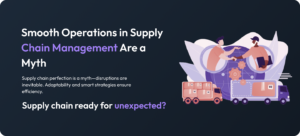
Let’s start with a fun fact, the term “supply chain” might sound like a dusty concept from a logistics textbook, but it’s actually the backbone of everything you buy, eat, and use. And here’s another fun fact (though not as funny if you’re managing one): supply chains can be a headache. This is where e-commerce comes in to save the day, like a superhero with an Excel spreadsheet cape.
In this blog, we’ll examine how e-commerce is helping manufacturers streamline supply chain management (SCM), making everything smoother, faster, and, dare we say, less chaotic.
“The supply chain motto: ‘It wasn’t me, it was the vendor!'”…Haha!!! Just kidding. Okay, let’s start
The Unsung Hero of Manufacturing
Manufacturing has always been about efficiency—getting products from Point A to Point B and sometimes Point C, D, or Z without losing your mind or your profit margins.
Enter e-commerce, the digital platform that’s not just for buying socks online but also transforming how manufacturers run their supply chains.
“Supply chains teach you that the shortest distance between two points is probably under construction.”
Why does this matter?
Well, eCommerce in supply chain management is like upgrading from an old Nokia phone to the latest iPhone.
Sure, you can still call people on both, but one of them has apps, navigation, and a camera that makes you look 10x cooler.
The role of E-Business in supply chain management is precisely that, it upgrades how manufacturers operate, providing tools to make processes leaner, meaner, and more efficient.
Here’s what e-commerce brings to the table:
- Transparency: With e-business platforms, everyone—suppliers, manufacturers, and distributors—is on the same page. No more “lost emails” or “I thought you sent that yesterday.”
- Speed: Automating orders, tracking shipments, and managing inventory is faster than trying to remember where you saved that Excel file.
- Cost Savings: Less manual work and fewer errors equals more money saved (and more budget for better coffee in the breakroom).
The Role of E-Business in Supply Chain Management
Now, let’s unpack this a little more. When we talk about e-business, we mean using internet-based tools and platforms to handle all those nitty-gritty supply chain tasks. Remember when people thought “the cloud” was just a weather phenomenon? Turns out, the cloud (and other e-business tools) is the key to creating smarter, more efficient supply chains.
Real-Time Visibility
Imagine being able to see your entire supply chain in real-time—kind of like those GPS trackers parents use to keep tabs on their teenagers. With real-time supply chain visibility, e-business platforms let you know exactly where your raw materials are, when they’ll arrive, and what’s holding things up.
Automation That Works While You Sleep
Thanks to automation, many supply chain tasks that used to take hours (or days) can now be done faster than you can brew a cup of coffee. From order processing to invoicing, supply chain automation keeps things running smoothly, even when you’re off the clock.
Smarter Supplier Management
Let’s be honest: managing suppliers can feel like herding cats. E-business platforms simplify this process by helping you monitor performance, manage contracts, and even forecast future needs. It’s like having a personal assistant who never needs coffee breaks.
How B2B E-Commerce Is Changing the Game
When you hear “e-commerce,” you probably think of buying things like shoes or kitchen gadgets on Amazon.
But here’s the thing: B2B (business-to-business) e-commerce is a whole other beast. It’s not about impulse purchases—it’s about manufacturers buying, selling, and managing massive orders with the efficiency of a Swiss watch.
And that’s where the role of SCM in B2B eCommerce comes in. Supply chain management isn’t just a supporting act here—it’s the star of the show.
Without effective SCM, B2B e-commerce would be like trying to run a marathon in flip-flops—messy, inefficient, and probably painful.
Customized Solutions at Scale
B2B customers often need highly customized products, whether it’s specific materials, sizes, or delivery schedules.
Thanks to e-commerce, manufacturers can now manage this customization at scale without losing their sanity. (Okay, maybe just a little sanity during peak seasons.)
Faster Order Fulfillment
In the world of B2B, slow order processing is a dealbreaker. E-commerce platforms integrated with SCM systems ensure that orders move through the pipeline quickly, avoiding delays and keeping everyone happy.
Improved Collaboration
Collaboration is the secret sauce of a successful supply chain. With e-commerce tools, manufacturers, suppliers, and distributors can share information more easily, ensuring that everyone is working toward the same goals. Think of it as a group project where everyone actually does their part for once.
Technologies Driving E-Commerce in SCM
If e-commerce is the engine driving supply chain improvements, then technology is the fuel keeping it running. Here’s a closer look at the tech that’s making life easier for manufacturers:
Artificial Intelligence (AI)
AI is like having a crystal ball for your supply chain. It predicts demand, identifies risks, and suggests the best ways to optimize production. Plus, it doesn’t complain when you work overtime.
Internet of Things (IoT)
IoT devices are those handy gadgets that monitor everything from shipment locations to equipment performance. Think of them as the supply chain’s version of a Fitbit—constantly tracking and reporting so you can stay on top of things.
Blockchain
Yes, blockchain is more than just a buzzword. It ensures secure, transparent transactions, which is crucial when you’re dealing with multiple parties across the globe. It’s like having a notary public for your supply chain, but cooler.
Cloud Computing
Cloud-based solutions allow manufacturers to manage their supply chain data from anywhere. Whether you’re at the office or lounging on a beach (we can dream, right?), the cloud has your back.
Challenges in E-Commerce-Driven Supply Chains (And How to Handle Them)
Of course, it’s not all sunshine and rainbows. Integrating e-commerce into your supply chain comes with its share of challenges. Here’s how to tackle them without losing your cool:
Cybersecurity Risks
With great digital power comes great responsibility—and great cybersecurity risks. Protecting your data (and your customers’ data) should be a top priority. Think of it as building a digital moat around your castle.
Integration Woes
Integrating e-commerce platforms with existing SCM systems can feel like trying to fit a square peg into a round hole. The key is to work with experienced partners who know how to smooth out the rough edges.
Adapting to Change
The market changes faster than a toddler’s mood. Your e-commerce platform needs to be flexible enough to adapt to new trends, technologies, and customer demands. Pro tip: If your platform feels outdated, it probably is.
Best Practices for Manufacturers
If you’re ready to jump on the e-commerce bandwagon (and trust us, you should be), here are some best practices to keep in mind:
- Start Small, Think Big: You don’t have to overhaul your entire supply chain overnight. Start with one or two processes and expand from there.
- Invest in Training: Your fancy new e-commerce platform won’t do much good if your team doesn’t know how to use it. Make training a priority.
- Focus on the Customer: At the end of the day, a well-oiled supply chain benefits your customers. Keep their needs front and center.
The Bottom Line
E-commerce is no longer just a nice-to-have for manufacturers—it’s a must-have. From improving transparency and speed to enabling better collaboration, the role of e-business in supply chain management cannot be overstated. Add in the power of SCM in B2B eCommerce, and you’ve got a recipe for success.
“SCM is the art of solving today’s problems with yesterday’s data in hopes of meeting tomorrow’s deadlines’’
So, whether you’re looking to streamline operations, cut costs, or just make your life a little easier, e-commerce has got your back. And if you ever feel overwhelmed, just remember: even the best supply chains had to start somewhere (probably with a lot of trial and error).
